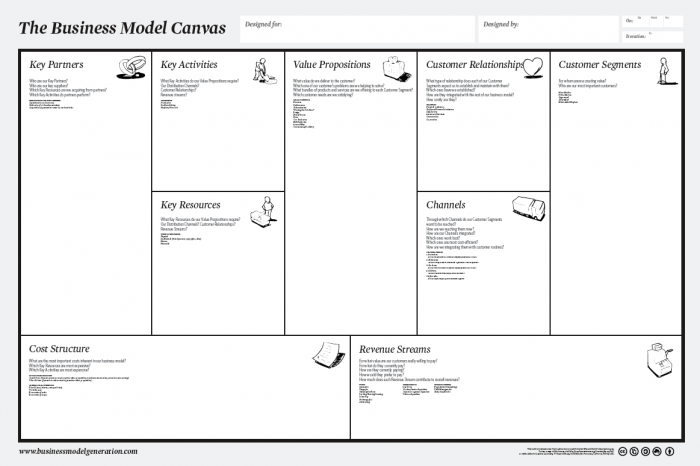Nina: Please introduce yourself.
My name is Alex Osterwalder from Switzerland and I work on business models and “Business Model Innovation”.
Nina:Would you please describe what you understand by “Business Model Innovation” and “Business Model Canvas”?
Business Model Innovation is basically the process of creating value in new ways for customers and companies. The Business Model Canvas is a practical tool that we invented to help companies describe, design, challenge and ultimately invent new business models. It is a very visual tool, based on nine building blocks that allow you as an organization to describe your business model.
Nina: That sounds easy – but I´m afraid it isn´t. What makes a business model successful?
Pointing out what in particular makes a business model successful is challenging. There are a lot of factors. The difficult thing is to dissociate what comes from the model itself and what comes from sound implementation or a great team. Even a great business model on paper can fail if you don´t have the right people to execute it and the right organizational structures to implement it.
There are, of course, a couple of questions with which you can stress test your business model’s design. I recently wrote about it on my blog BusinessModelAlchemist.com. At the end of the day, however, the market and customers are the only relevant judges of your business model. There will never be a way to assess upfront, before going to market, if a business model will be successful or not.
 Nina: You said that there are nine building blocks. What exactly are those nine blocks about?
Nina: You said that there are nine building blocks. What exactly are those nine blocks about?
I can enumerate the nine blocks, but what is really important is actually to try to sketch them out, draw them on paper or a on a poster to make them tangible. The nine building blocks start with the customer segments, which are the customers for whom you create value. You create value for them with a value proposition. For each customer segment, for each job-to-be done for your customers you will have a different value proposition. For example, a pharmaceutical company creates value for doctors, patients, and insurances. When you´ve defined who you create value for you should describe which channels you use to reach them. Is that a sales force, is that a chain of stores, is it the internet. That’s the third block. The fourth block is the customer relationship that you establish. For example, a private bank will establish a very long term and personal relationship based on a banker, on a person. Amazon will establish an automated relationship. But also fairly long term and not just transactional, because they will recommend books too based on your and other customer’s buying behavior. The next building block is “revenue streams”. Here you describe how exactly you are earning money and what customers are willing to pay for. E.g. “Google”: Google earns most of their revenues from search advertising. But what makes this revenue stream so powerful is that they auction off the search terms. They don´t just sell key words, but they put advertisers in competition one against each other. After describing the first five building blocks of your business model you have to ask yourself what kind of infrastructure this requires. The first element is the key resources. Here you describe what the key assets are that you need to create and deliver value. Do you need patents? Do you need a brand? Do you need factories? The next thing to describe are the key activities required. These are the key things that you have to be good at performing in your business model. Is it programming? is it managing servers? is it marketing and sales? What are the key things you have to be really good at performing? And since we are in the 21st century the next building block is partners that you work with to create value because you are not going to do everything yourself. The right partners can leverage your business model. Finally, the previous three building blocks will allow you to easily describe the last one, which is your business model’s cost structure. So, there you have nine building blocks that allow you to easily and quickly describe your business model. Again, the most important is not just to enumerate these building blocks. It´s really important to sketch out the nine blocks. That’s why we call it a business model canvas: You draw the business model. You make it tangible and visible. That’s a very important part.
Nina: What´s the difference to existing business model theories?
Well, when we started out eleven years ago I was working on my dissertation on business models and there were a lot of people talking about business models. There were lots of conceptual models out there. The key difference is that we took all those concepts, made a synthesis, tried to simplify them and then designed a model which we rigorously tested in the market with companies, with entrepreneurs, and with senior executives. It was a scientific approach. We called the output “Business Model Ontology” before it became “Business Model Canvas” later on. Once the dissertation was published, the method was increasingly used throughout the world. So the model was “stress tested” by the market. Today a lot of companies around the world use the “Business Model Canvas” to describe their business models, to challenge them and invent new ones.
Nina: And now in regards to Business Process Management, why do companies need a connection between Business Process Management regarding their business strategy?
I think the difficult thing today is that companies have to differentiate themselves. Companies have to try to stand out. In some industries business models are transforming because the old ones just don´t work anymore like in the pharmaceutical industry. Simply redesigning processes, which is not an easy task, won´t be sufficient for companies to stand out or to regain or keep a competitive advantage. Many companies are now facing the task of having to extend or reinvent their business models. So that’s where the action happens. Yet, as I pointed out previously even the best business model is not going to help a company succeed without good implementation. And when you say implementation you are talking about the right organizational structures and the right business processes. So being able to clearly map out how the business model - the blueprint of your strategy - translates into business processes is very, very important. You can design 10, 20 different business processes for one business model. You will have to find the right one. It´s a pretty big challenge to design the right processes for a business model that you want to put in place. This is something we are only learning how to do in organizations today.
Nina: I guess that’s where you see the potential in the partnership with Software AG?
.png) Absolutely. I think you are very strong in that area and you already have tools that help companies a lot. The missing link is the last connection with strategy. With the concept of strategy maps, you started to create a strong link to strategy. The Business Model Canvas will allow us to go even further. Finding better ways to implement strategy is essential and that’s why I am interested in working together with you guys. I think we can really create value for companies because it´s a concrete problem that companies are facing today. That link between business models and business processes is not solved yet. By working together we can help companies in that area.
Absolutely. I think you are very strong in that area and you already have tools that help companies a lot. The missing link is the last connection with strategy. With the concept of strategy maps, you started to create a strong link to strategy. The Business Model Canvas will allow us to go even further. Finding better ways to implement strategy is essential and that’s why I am interested in working together with you guys. I think we can really create value for companies because it´s a concrete problem that companies are facing today. That link between business models and business processes is not solved yet. By working together we can help companies in that area.
Nina: In which industry do you see the biggest challenges for business model innovation?
I wouldn’t want to single out a single industry. In the mobile phone industry business model innovation has happened continuously over the last decades. This industry is familiar with the business model innovation challenge. Even so, they still don’t know how to deal with the topic, as the recent challenges to the business models of “Nokia”, “Microsoft” and “RIM” with the “BlackBerry” show. All of them have been – at least temporarily - sidelined by “Apple” and “Google”.
However, these kind of disruptions to established business models is not only happening in the IT or telecom industry. It is happening across the board and a lot of companies in vary different sectors are facing the challenge of business model innovation. There are some I am looking at a little bit closer. For example, the banking industry has a strong need for new business models. Another very interesting area facing enormous business model challenges is the pharmaceutical industry. The old based on the development of blockbuster drugs doesn’t work anymore and it´s not quite clear how pharmaceutical companies are going to replace their revenues coming from expiring patents. Generic drugs are going to decrease revenues of some companies by 10, 20, 50 per cent. What do you do in that kind of situation when you have to replace a large part of your business? Business model innovation is a viable answer.
But business model innovation is not just happening in the private sector. I had the opportunity to work together with some governmental organizations that are changing their business models. Surprising enough, they are interested in using the business model concept for some of their major challenges. Business model innovation is happening in places we wouldn´t have expected.
Nina: Can you give us some examples for successful(business model) innovations?
There are several interesting examples. One example that I find intriguing is how “Nestle”, the big Swiss nutrition company, is building a portfolio of business models in their coffee business. When they set up Nespresso, they started selling single portioned espresso for their innovative Nespresso machine directly to the end customer. It was the first time “Nestlé” sold to the end customer, which is a very different business model and it was extremely successful. Yet, they didn´t stop there. They continued with business model innovation in the coffee business by creating “Dolce Gusto” which is another machine that operates with a slightly different business model. They are developing a portfolio of business models in their coffee business. That is exciting, because I think that is the future: from product portfolios to business model portfolios.
An exciting area where a lot of new business models are emerging is the entrepreneurial sphere. One of the examples I find particularly fascinating is how a company called “SunEdison” boosted the adoption of solar panels in the US. They did that not through a new technology, but through a business model innovation. Jigar Shah, the founder of “SunEdison”, solved what was broken in the solar panel manufacturing industry. For years, solar panel manufacturers were asked to spend substantial upfront investments for solar panel installations. Through a business model innovation SunEdison was able to provide solar panels for free. This innovation transformed the entire industry. We often first think of technology innovation as the solution, but in this case it was the business model that made the difference. What is exciting with the SunEdison example is that business model innovation sometimes allows you to solve customer problems or customer jobs-to-be-done that were simply not possible with the traditional business model.
Nina: As we have many students in our community – do you have a good piece of advice for founders of a new business/ the new entrepreneurs?
I would give two pieces of advice. The first one is: realize that every product or technology and every business idea can have multiple business models. You have to really go through a design process where you think through five, ten, twenty different business models for the same starting point. One where you give away the product for free, one were you have only variable costs and no fix costs; one where you work with a very strong partner or even a competitor. Creating business model prototypes and thinking them through before selecting one is important. It helps you not fall in love with your first ideas and strive for better alternatives. That’s the one piece of advice.
The second piece of advice is that even if you have the smartest team and you figured out your business model, don’t forget that it is still just a series of hypothesis, a series of guesses. You don’t know yet if it is really going to work. So before starting to build your business model what you really want to do is test the pieces of it with customers and partners. When you learn that something doesn’t work you can pivot your business model until you find workable options. You only start building it when you are sure it will succeed. That approach to testing business models is a very powerful method described by Silicon Valley guru Steve Blank in his book The Four Steps to the Epiphany. That is very different from the past when we used to write and invest in business plans. But business plans do not survive the first contact with customers to quote Steve blank. So don’t even take the time to write a business plan. Focus on the design of and search for the right a business model.
Vita Alex Osterwalder
Alexander Osterwalder is an entrepreneur, speaker and business model innovator. Together with Professor Yves Pigneur he co-authored Business Model Generation, a global bestseller on the topic of business model innovation. His Business Model Canvas, a tool to visualize, challenge and (re-) invent business models is used by leading organizations around the world. Alexander is a frequent keynote speaker and has held guest lectures in top universities around the world, including Stanford, Berkeley, IESE and IMD. The Business Model Foundry, his current start-up, is building strategic tools for innovators. The Business Model Toolbox for iPad is the Foundry's first application. Alexander holds a PhD from HEC Lausanne, Switzerland, and is a founding member of The Constellation, a global not-for-profit organization aiming to make HIV/AIDS and Malaria history.



RAMES PB on
Concepts ....like the Business Model Canvas ....... need tools like ARIS to model and explain. Models could be so complex that innovation of management thought and mastery of tools go hand in hand. But to accept that businesses can be modelled without business plans could mean that modelling will become an end in itself. But this is just one way -- not necessarily the right way-- of looking at it. Business Plans defines the canvas and the tools help you stay there. Some business plans would even involve no change, and tools still help building such business models.